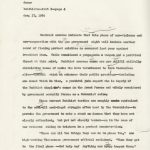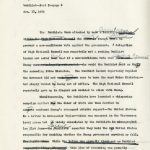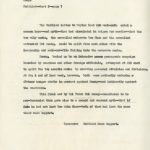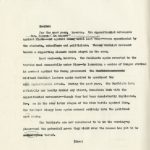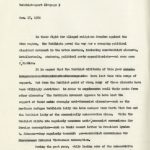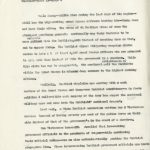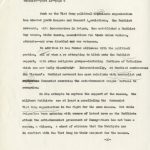1964, December 17, “Communist-led Buddhist Movement”
deepe
buddhists–Part I–Page 1
Dec. 17, 1964
SAIGON–The Communist-led[?] Buddhist movement has declared an irreversible state of total war on the American-backed government of Prime Minister Tran Van Huong, reliable os observers indicate.
Perhaps less noticed but more significant, the powerful Buddhist politico-priests have declared war on the legal mechanisms which would select the future gov any future government.
Two other powerful forces–the Vietnamese armed forces and Americans–are trying to arbitrate the differences between the two warring camps.
But, hopes for compromise appear slim.
The odds are heavily against the 63-year-old cherub-faced Prime Minister winning the battle–the question is whether he will have the opportunity and (More) power to crackdown positively on the Buddhists leadership, which he considers pro-Communist, “playing the Communist game,” before he falls.
(More)
deepe
buddhists–Part I–page 2
dec. 17, 1964
The prediction of bloodshed and violence are now more than idle ch speculation and coffeehouse chatter. Prime Minister Huong has personally been warned of “blood consequences” by members of the official high High National Council–and the predictions of a coup d’etat and [political?] turmoil has been discussed by members of the council during official[Brief?] meetings, according to reliable sources.
Observers here believe the one other powerful force in the country–the Communist Viet Cong–are waiting for the showdown with glee, knowing that any turn of events will may help them profit them.
The powerful Buddhist oppositionist movement lead by skilled political-priests Thich Tri Quang and Thich Tam Chau sparked the overthrow of the regime of Ngo Dinh Diem, a Catholic, last year and were implicated in the “demi-coup” we which toppled Maj. Gen. Nguyen Khanh from the Prime Minister’s Office during lateA August student demonstrations.
The question of who and what government would follow Huong should he fall is still considered speculative. However, observers here view as especially significant the re-emergence of an Armed Forces Council–which they interpret as being a de facto military junta–.
deepe
buddhists–Part I–page 3
dec. 17, 1964
Should the Huong government–and the legal apparatus for selecting future governments–be toppled, Vietnam‘s third military junta in thirteen months is considered likely to approrpiate polt jettison General Khanh into civilian authority again.
In attempts to quicken the pace and intensity of their fight against the Huong government, the politico- Buddhist politico-priests have launched a series of hunger strikes to be coupled with their constant “war of communiques.” The short-term expectations are that the Buddhist next move of the Buddhist leadership would include a brillian brilliant demonstration of saffron-robed monks to the Presidential Palace to protest against the government; perhaps the hunger strikes would be shifted to the provinces and to [?] include the Buddhist laity; perhaps a distributed Buddhist organiza association of disabled war veterans would launch a protest march.
Since t The government has declaredby declaring demonstrations illegal and subject to being stopped by force, and would be in an embarrassing position to arrest a peaceful demonstration of Buddhist bonzes or disabled war veterans.
(More)
deepe
buddhists–Part I–page 4
dec. 17, 1964
Buddhist sources indicate that thisthe current phase of non-violence and non-cooperation with the goe government might well include another round of flaming protest suicides such as occurred last year against President Diem. While considered a propaganda e weapon and a political threat at this point, Buddhist sources care are now skilfil skilfully circulating names of monks who have volunteered to turnburn themselves alive–includi which eh enhances their public prestiage–including one named Thich Ho Giac, a youthful judo expert who is deputy of the Buddhist chaplain’s corps in the Armed Forces and widely considered by government security forces as a Communist cadre.
These current Buddhist tactics are roughly remis equivalent to the semi-ill semi-legal struggle often used by the Communists–to provoke the government to make a stand on issues that they have not clearly authorized, but yet not clearly banned–as in the case of war veterans riding in trishaws in a protest demonstration.
“These are all the things they can do in phase two,” one worried high-ranking Vietnamese government official exclaimed. “When they get to the final phase –God help us.’ Anything can hpapp happen then.”
(More)
deepe
buddhists–Part I–page 5
dec. 17, 1964
The Buddhists in the have in Recent days intensified their propaganda effort i and their changed the course of their skilfully maneuvered campaign since Prime Minister Huong entered the office on November 1. At that time the central point of their attacks werewas against several minist unnamed ministers in the government. This line continued until the violent, bloody student demonstrations of late au November when the Political bonze Thich Tam Chau began to unroll a scathing campaign ago against the Prime Minister himself, For death two monks, blaming him for naming an “anti-revolutionary” government, for “oppressing” student demonstrators in order to preserve order p security in Saigon, a nd then vo for imposing martial law. They also accused him of forming separatism by favoring those, like himself, who were born in the Mekong Delta region of the country, once known as Cochinchina.
Last week, weekend, however, in a series of masterfully written, precisely worded communiques, the Buddhists shifted tactics by completely ignormi ir ignoring the existence of Huong butand by instead concentrateding their fire on the supporters–and the creators of Huong his supporters and–and his creators.
The three pillars of the Huong regime are, the Prime Minister and his Cabinet, the Chief of State Phan Khac Suu and the 159-man High National Coucnil. which roughly operates like the United Sta tes Senate but also ho has extensive powers in approving the But both the High National Council and the Chief of Sta te have extensive powers in approving or removing the Prime Minister, ratifying his Cabinet and in drawing up procedures for the future National Congress which would draft the permanent Constitution.
deepe
buddhists–Part I–page 6
dec. 17, 1964
The Buddhists then attacked by name a leading politician within the High National CouncilCouncilman who controlswields enough votesinfluence to prevent a non-confidence vote against the government. A delegation of High National Council men reportedly met a ranking Buddhist leader and asked themHim that if a non-confidence vote were given andtaken against Huong were out legally out ousted–who would the Buddhists want as their the suceeding Prime Minister. The Buddhist leader reportedly replied the movement did not want to name care to name the next Prime Ministerp–but simply wanted Ho Huong out of office. The High National Council reportedly gave up in disgust and decided to stick with Huong.
Simultaneously, the Buddhists have launched a whispering campaign against Pha the Chief of State and then decided to confont confront Huong‘s strongest outside support–the United States. In a letter to Ambassador Taylor–which was censored in the Vietnamese local press but wh widely circulated by the Buddhists in mimeographed lea flet form–the Political Buddhists asserted they held the rox United States responsible for decided whether the Huong government survived or fell. The implication While the letter was promptly dismissed as Buddhist propaganda line, it served this line of reasoning was promptly dismissed by official Americansas Buddhist propaganda, even the most anti-Communist, anti-Buddhist Vietnamese agreed that the support of the American government iswas the first prerequisite for any futureVietnamese government.
deepe
buddhists–Part I–page 7
The Buddhist letter to Taylor last wok week-and ended a common hope–and myth–that had circulated in Saigon for months–that the two wily monks, the so-called moderate Tam Chau and the so-called extremist Tri Quang, could be split from each other with the leadership and rank-and-file falling into the moderate ranks.
Huong, backed up by an intensive pros propaganda campaign launched by American and other foreign officials, attempted at all cost to split the two ascetic monks by creating personal rivalries and divisions. At the t end of last week, however, both were patiently enduring a 48-hour hunger strike in protest against Huong–and indirectly against the Americans.
This final act by Tri Thich Tri Quang considered to be pro-Communist then gave rise to a second and current myth–that if Tri he had not lost Tam Cahu Chau–both of them had lost the mass their mass support.
Tomorrow: Buddhist Mass Support.
“Communist-led Buddhist Movement”
Part 2, December 17, 1964
deepe
buddhists–Part II–page 1
dec. 17, 1964
SAIGON–A sudden flipflop in x the current tactics of the Communist-oriented militant Buddhist movement has produced the illusion it has lost wha t what it m wants most–the masses.
A common and widely held viewpoint of political analysts in Saigon point states that the Buddhist movement has not been able to capture the popular support and enthusiasm that it mustered to spark the overthrow i of the Ngo Dinh Diem regime last November.
But other political observers argue that the Buddhists have the potential power to topple the current government of Tran Van Huong–but it has yet to issue an all-out appeal for public support.
According to this line of reasoning, the Buddhist movement upon launching was the spearhead in the first drive to overthrow the Catholic President last year which and the supporting which they accomplished h with [and by supporting?] spectacular flaming suicide burings burnings of Buddhist monks and one Buddhist nun. The second stage of protest was handled by the students, politicians, intellectuals–and in the final stage by the armed forces who violently overthrew and assassinated Diem.
sa
deepe
buddhists–part II–page 2
In the
For the next year, however, the oppositionist movements against Gen. Nguyen Khanh in August–and against HuongTran Van Huong until last week–were spearheaded by the students, schoolboys and politicians. The asBuddhist movement became a supporting element which stayed in the rear.
Last week-end, however, the Buddhists again reverted to the tactics used successfully under Diem–by launching a series of hungers trikes in protest against the Huong government the Buddhist movement militant Buddhist leaders again decided to speakrhead the mitx oppositionist attack. during the past year, the Buddhists have officially and loudly denied any direct, immediate link with the oppositionist, movements–though they had been consistently implicated. Now, as in the ater later stages of the Diem battle against Diem, the Buddhist clergy have again entered actively into the political area arena.
The Buddhists are now considered to be in the warming-up phase–and the potential power they wield over the masses has yet to be called upon. tested.
(More)
deepe
buddhists–part II–page 3
dec. 17, 1964
In their fight for alleged religious freedom against the Diem regime, the Buddhists paved the way for a sweeping political dissident movement in the urban centers, including non-Buddhist elements, intellectuals, students, political party oppositionists–and even some Catholics.
It is argued that the Buddhist militants of this year can no longer muster this kind of ide range of have lost this wide range of support. But from the Buddhist point of view, many of these elements have been willingly sacrificed in order to supplement swell their ranks from other elements. The Buddhist movement appears to have lost the support of their anti- strongly anti-Communist elements–such as the northern refugee Buddhists laity who have escaped from North Viet Nam and the Buddhist laity of the economically conservative class. While the Buddhist milita nts regularly announce anti-; communist communiques for foreign consumption–such as their recent letter to President Lyndon B. Johnson–they regularly transmit pro-neutralist communiques for Vietnamese internal Vietnamese consumption.
During the past year, while loading some of the conservative anti-Communist rank-and-file, they have continued to strengthen both ghe their vertical organization reaching from the national level to the villages and their horizontal organizationsal reach touching persons in all walks of life.
deepe
buddhists–part II–page 4
While Huong–unlike Diem during the last days of his regime–still has the high-ranking armed forces officers backing him–Huong does not have their wives. The wives of th Buddhist wives of even the strongest pro-Huong generals continually nag their husbands to be more partisantmoderate with the Buddhists,and instead of cracking down on them, and to oppose Huong. The Buddhist whiser whispering campaign claime claims to have a t at least 2,000 Armed Forces officers who are prepared to side with them instead of with the government in a showdown. While this claim inx may be exaggerated, the emotional pulldivisiveness of the Buddhists within the Armed Forces is of more deep concern to the highest ranking [military?] officer.
Similarly, Buddhist chaplains now serving with a each service of the Armed Forces and three-man Buddhist committees–a de facto politica l cell–within each company of the Army has sapped the emotional military more and more into the Buddhists’ emotional dragnet.
Last week, a Viet Buddhist communique written for r Vietnamese rcadre boosted of having seventy per cent of the police force on their side instead of that of the government’s in the event of a showdown.
One Vietnamese housewife recalled that low-ranking government officials in the precincts of Saigon–while continuing their official duties–was as also enthusiastically pushing the Buddhist propaganda line. These lower-ranking Buddhist government officials are known to have given the Buddhists valuable intelligence information about families living in each city block.
deepe
buddhists–part II–page 5
Buddhist representatives for each block have been calling on housewives and families telling them to “be alert” for any call for Buddhist-sponsored demonstrations.
During the past year, the Buddhists have strengthened considerably their vertical organization running from the Saigon headquarters to the h regional, provincial and village offices. Last year, for example, the Buddhist movement operated in its stronghold area of Central Viet Nam much like a secret society, as the monks continuously moved about for frea fear of arrest from Diem agents. Today, however, it is readily acknowledged that the militant Buddhist wing is strong enough in terms of organization and mass support “to do anything it wishes up there.” It is virtually without opposition; and exhaustive attempts to help the victims of a recent flood in that area presumably galvanized their support even more.
In short, the vertical organization of the Buddhist movement appears to copy that of the Saigon government; the horizontal organization appears to copy that of the Communist-led National Front o for the Liberation of South Viet Nam.
deepe
buddhists–part II–page 6
Much as the Viet Cong political organizato organization has created youth Leagues and Peasant Associations, the Buddhist movement, with headquarters in Saigon, has established a Buddhist Boy Scouts, Girl Scouts, associations for trade union workers, students–and even disabled vet war veterans.
In addition it has formed alliances with the political parties, allmany of whom a–re attempting to hitch onto the Buddhist support, with other religious groups–including factions of the Catholics which are now badly disunited.— Internationally, at Buddhist conferences the Vietnam‘s Buddhist movement has open relations with those neutralist and diplomatic Communist countries the anti-Communist Saigon government refuses to recognize.
In its attempts to capture the support of the masses, the militant Buddhists are at least a paralleling the Communist Viet Cong organization in the fight for the same masses. But while Saigon in Recent days has been spinning with rumors of latest news as the Buddhist attack and the anti-Communist government of Huong–there has not been a rummor, a whisper, a shred of evidence that the Buddhists are in conflict with the Viet Cong in their conquest for the masses.
-30-
Read Previous Article: 1964, December 11, “First American Helicopters Arrived in Vietnam”
Read Next Article: 1964, “Nowhereville”




